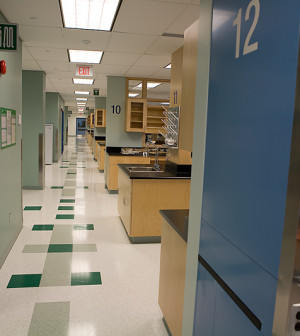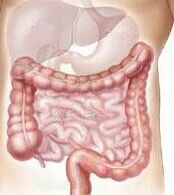- Skip Storing This Everyday Product in the Fridge Door
- Green Tea + B3 Pairing May Boost Brain Health
- Navigating Your Midlife Crisis: Embracing New Possibilities
- City Raccoons Showing Signs of Domestication
- Mapping the Exposome: Science Broadens Focus to Environmental Disease Triggers
- One Week Less on Social Media Linked to Better Mental Health
- Your Brain Changes in Stages as You Age, Study Finds
- Some Suicide Victims Show No Typical Warning Signs, Study Finds
- ByHeart Formula Faces Lawsuits After Babies Sickened With Botulism
- Switch to Vegan Diet Could Cut Your Greenhouse Gas Emissions in Half
At-Home Stool Test for Colon Cancer Called Accurate, But Not Foolproof


A newer type of test that looks for hidden blood in the stool is an effective way to screen for colon cancer, a research review suggests.
The tests, called fecal immunochemical tests (FITs), are done at home and detect tiny amounts of blood in the stool — a possible sign of colon cancer. In the new review, researchers found that across 19 studies, FITs caught more than three-quarters of colon tumors, and were very good at ruling out the cancer.
Experts said the findings give “reassurance” that an already commonly used test performs well.
“FIT testing continues to have very good potential as a screening tool,” said Dr. Elizabeth Liles, of the Kaiser Permanente Center for Health Research in Portland, Ore.
Liles and her colleagues reported their findings in the Feb. 4 issue of the journal Annals of Internal Medicine.
Experts currently recommend that people at average risk of colon cancer start getting screened at age 50. And they can choose from several options, including yearly stool tests followed by a colonoscopy if the result is positive, a colonoscopy done every 10 years or sigmoidoscopy every five years. Colonoscopy and sigmoidoscopy are both invasive procedures that inspect the interior of the colon, but sigmoidoscopy is less thorough — looking only at the lower portion of the colon.
In recent years, more doctors have been using FITs instead of the traditional fecal occult blood test, because they’re better at picking up cancer and they’re easier for people to use.
Still, individual studies have had a fairly wide range of findings on the FIT tests’ sensitivity — that is, their likelihood of giving a positive result when a person has colon cancer.
The new study gives a clearer idea of how the tests perform on average, according to a colon cancer expert who was not involved in the research.
“It gives some very valuable information,” said Dr. Andrew Chan, a gastroenterologist at Massachusetts General Hospital in Boston.
But there are still bigger questions, Chan said. Experts still don’t know which screening test is most effective at preventing deaths from colon cancer.
Colonoscopy is widely considered the “gold standard” for screening, because it allows the doctor to visually inspect the interior of the colon — and, if necessary, remove precancerous growths called polyps.
Chan said it’s not yet clear how FIT and colonoscopy compare when it comes to cutting people’s risk of dying from colon cancer.
There are studies under way, though. A large U.S. government trial is randomly assigning people to have either a colonoscopy or an annual FIT screening, then following their rates of death from colon cancer over 10 years. (In the United States, colonoscopy is the most common screening method, followed by stool testing. Few doctors perform sigmoidoscopy.)
For the new review, Liles and her colleagues analyzed 19 studies done since 1996, looking at eight different brands of FIT tests. They found that the tests’ sensitivity did vary from study to study, but the discrepancy narrowed when the researchers excluded tests that are no longer on the market.
On average, the review found that FITs catch about 79 percent of colon cancers, and their specificity consistently tops 90 percent. That means the tests accurately give a negative result to more than 90 percent of people who do not have colon cancer.
One surprise, Liles said, was that FITs that require two or three stool samples performed no better than single-sample tests. That matters, she said, because people might be more willing to do the test if it’s simpler.
FIT screening is already fairly easy. Like older stool tests, they’re done with a take-home kit: You use a brush to get a stool sample, and then mail it to a lab. But unlike older tests, FITs don’t require any diet or medication restrictions in the days before the test.
The simplicity of the stool test is an obvious advantage over colonoscopy screening, Liles said. But she agreed that more research is needed to know which screening test is more effective at saving lives.
The U.S. National Institute of Diabetes and Digestive and Kidney Diseases and the National Cancer Institute provided much of the funding for the review.
So which exam should you choose? “That decision is between you and your doctor,” Chan said. What matters most, he added, is that “some form of screening is done.”
Liles agreed. “It’s said that the best screening test is the one that you’ll actually get done,” she said.
In the United States, the average lifetime risk of colon cancer is about one in 20, according to the American Cancer Society. In each of the past several years, more than 50,000 Americans have died of the disease — but the death rate has been declining for a couple decades, partly because of screening, the cancer society said.
Still, many people aren’t getting screened, Liles said.
In November, a federal report said that more than one-third of Americans aged 50 to 75 were not up to date with their colon cancer screening. That included 28 percent who had never had any type of screening test.
More information
The U.S. Centers for Disease Control and Prevention has more on colon cancer screening.
Source: HealthDay
Copyright © 2025 HealthDay. All rights reserved.










